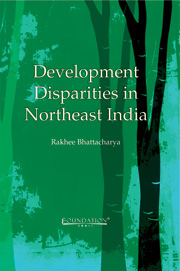Book contents
- Frontmatter
- Contents
- Preface
- List of Figures
- List of Tables
- 1 Challenges of Disparity in the Northeast
- 2 Dimensions of Disparity in the Northeast
- 3 Facets of Government Finance in the Northeast
- 4 Economy of Insurgency in the Northeast
- 5 Energy Interplay in the Northeast
- 6 Development Initiatives in the Northeast
- Index
Preface
Published online by Cambridge University Press: 05 June 2012
- Frontmatter
- Contents
- Preface
- List of Figures
- List of Tables
- 1 Challenges of Disparity in the Northeast
- 2 Dimensions of Disparity in the Northeast
- 3 Facets of Government Finance in the Northeast
- 4 Economy of Insurgency in the Northeast
- 5 Energy Interplay in the Northeast
- 6 Development Initiatives in the Northeast
- Index
Summary
Economic growth transforms the sociocultural landscape. Villages turn into towns, towns turn into cities, cities into metropolises, metropolises into megapolises and megapolises into global villages. An agricultural society transforms into a pre-industrial and then industrial society, and finally into an information and knowledge society. The lower middle classes increase their purchasing power to be reckoned among the middle classes, the middle classes among the upper middle, and the upper middle with the upper classes. A process of upward social mobility and transformation seems to be set off. Income from agricultural and manufacturing sectors gradually yields to income from the services sector, and a computer-based urban centred knowledge economy gradually seeks to replace the traditional community centred village economy. Going by these indicators of prosperity and growth, India has indeed prospered. It has changed from an impoverished fledgling democracy hardly expected to survive a few years, into a mature, vibrant republic that has withstood adversities, passed many tests and eventually achieved global recognition in its own right. An Indian is now proud just to be an Indian.
But what indeed is this ‘India’? A landmass with certain geographical boundaries, a heterogeneous cultural identity signifying a ‘unity in the midst of diversity’, a multicultural, multiethnic, multiracial, multireligious and multilingual entity identifiable by a single name ‘India that is Bharat’, that unlike Pakistan didn't become Hindustan? An India that lives in its five hundred thousand villages which remained unchanged as dynasty after dynasty slipped by, silent revolutions succeeded each other and various races assumed mastery over the land?
- Type
- Chapter
- Information
- Development Disparities in Northeast India , pp. v - xiPublisher: Foundation BooksPrint publication year: 2011

